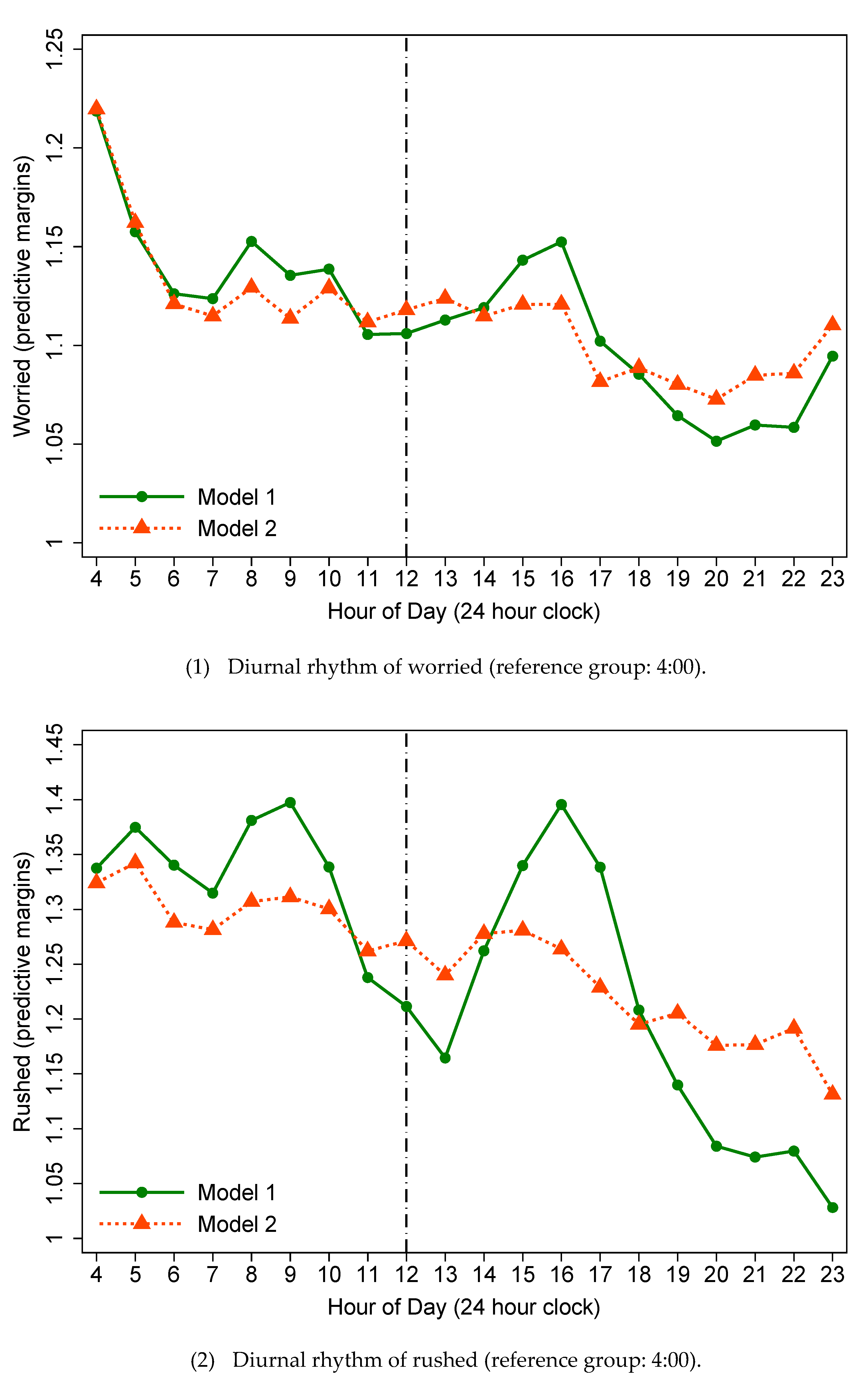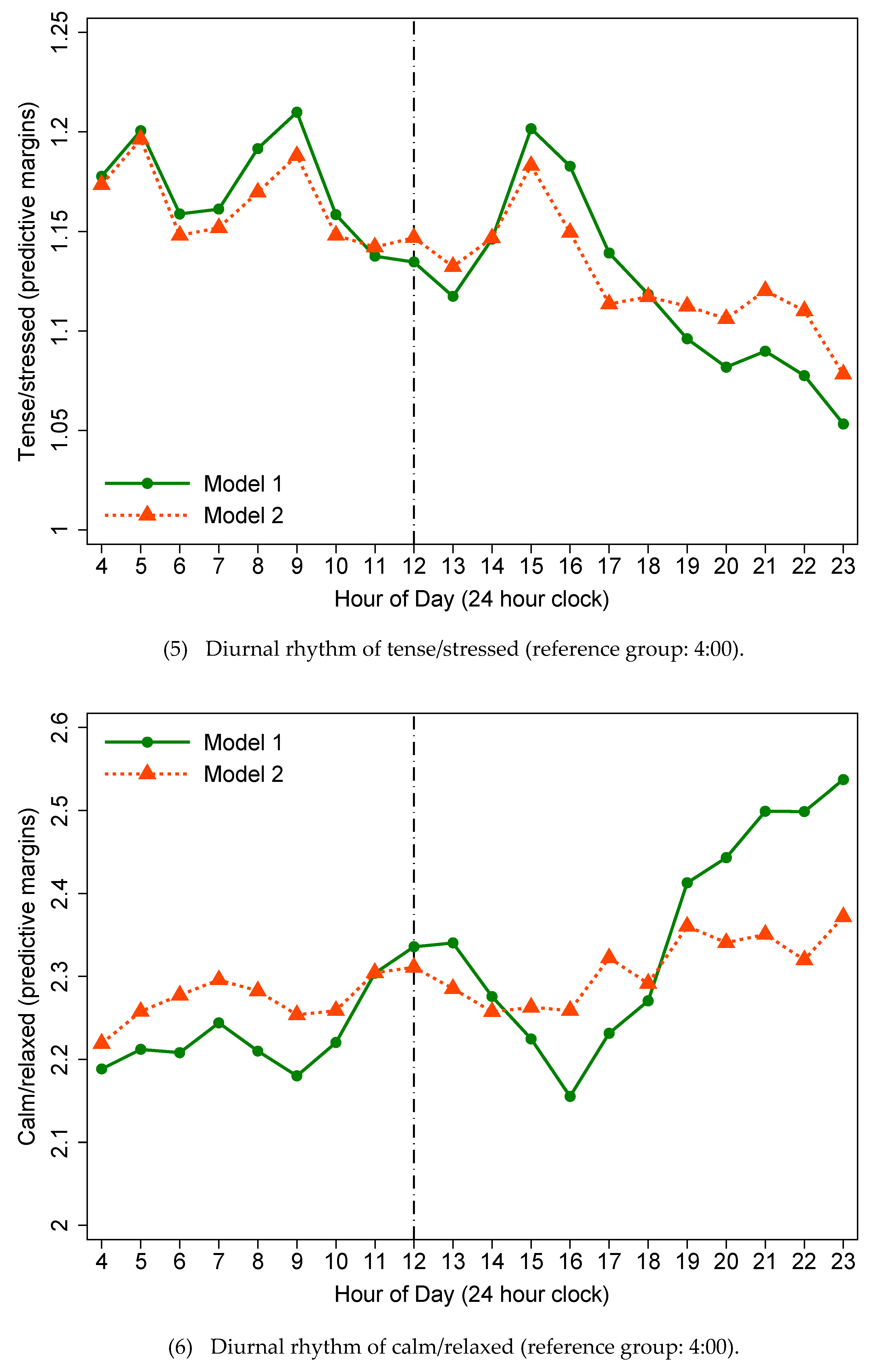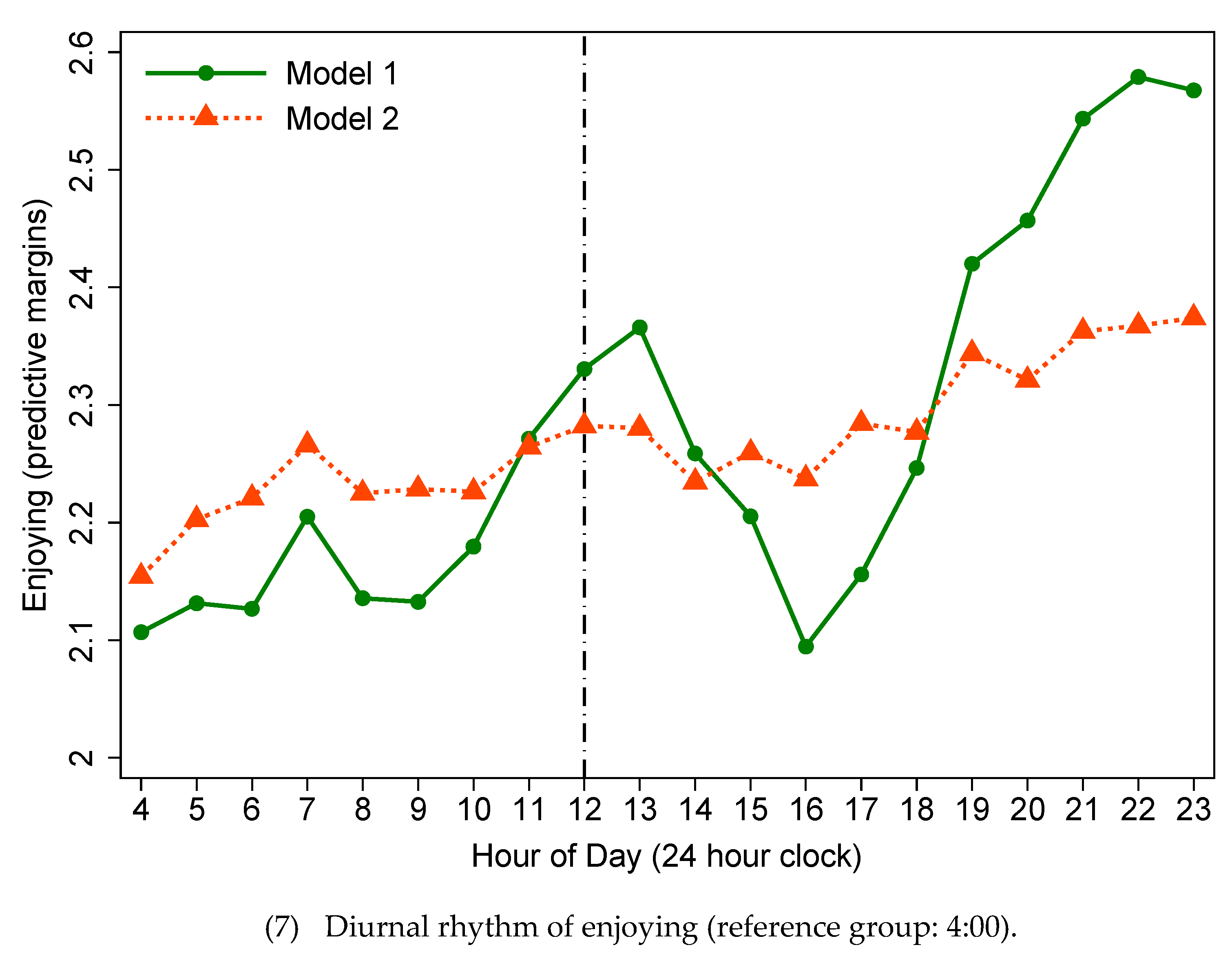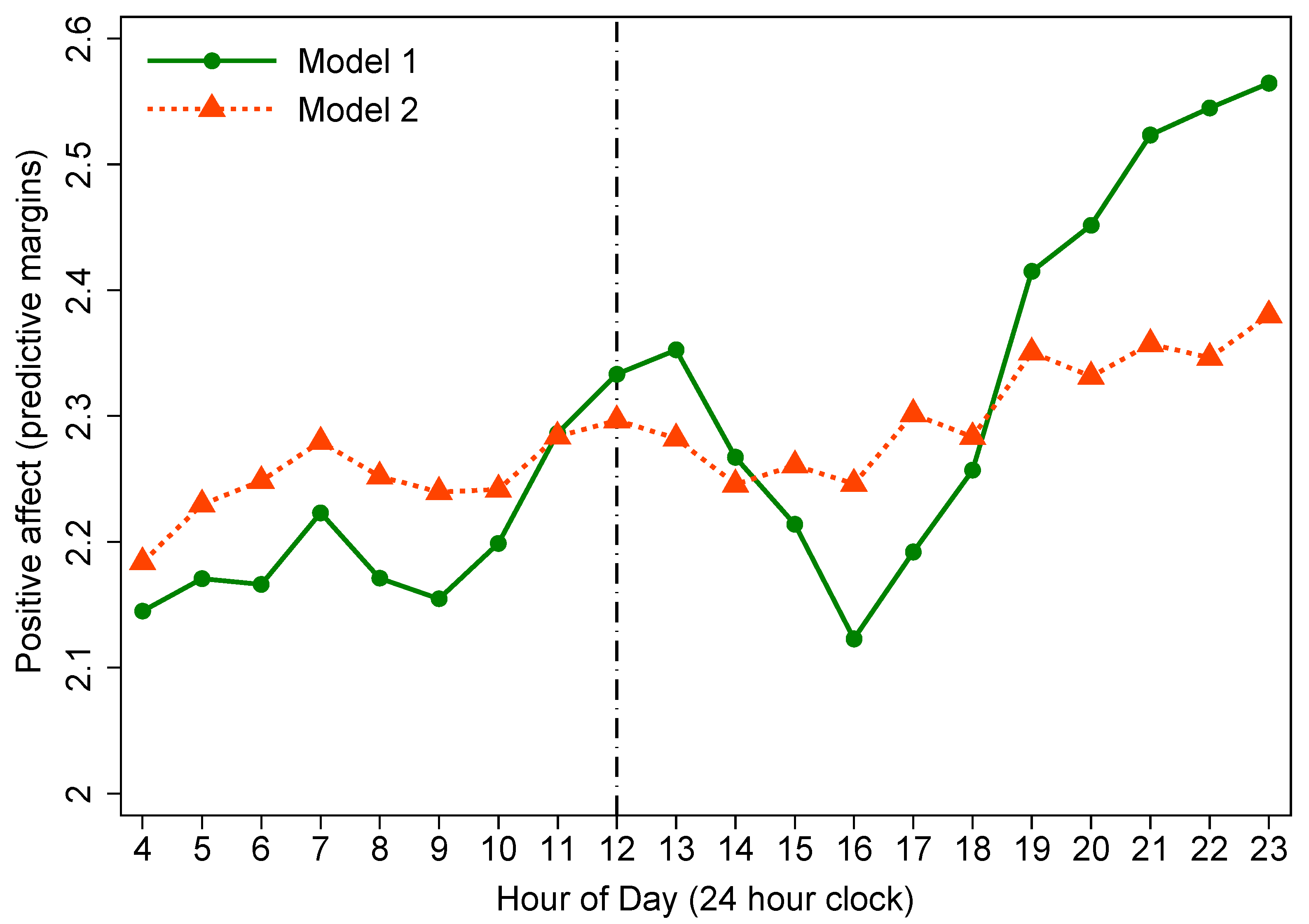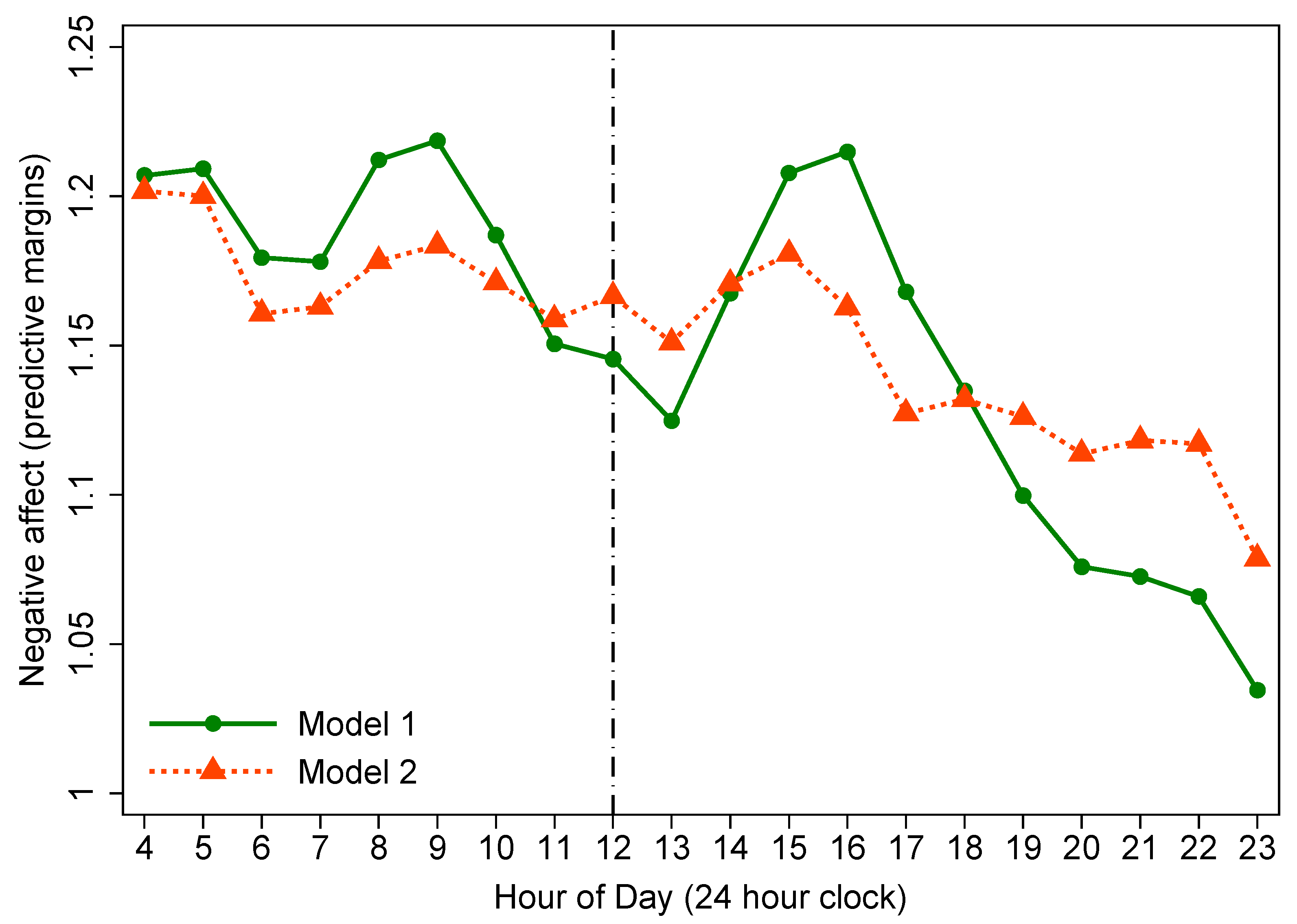1. Introduction
Although there are many indicators that reflect the quality of life, one key perspective is one’s own subjective evaluation—a construct known as subjective wellbeing (SWB) [
1]. Diener [
2] defined SWB as consisting of overall life evaluations, as well as day-to-day emotions. As an expansive and multidimensional term, SWB comprises both cognitive (e.g., life satisfaction) and affective components (e.g., happiness, sadness) [
3,
4]. Scholars emphasize that the affective component of SWB, which consists of moods and emotions, both positive and negative [
5], can reflect fundamental qualities of experience and plays a pivotal role in understanding and predicting human health and behavior [
6]. Some researchers measure affective SWB retrospectively, by asking a single question, like “Taking all things together, how would you say that you are these days: very happy, pretty happy, or not too happy?” [
7], or using rating scales, such as the Positive (e.g., cheerful) and Negative (e.g., irritable) Affect Schedule, where people rate the intensity of several emotions over a specific time frame [
8]. Others prefer to measure affective SWB by capturing actual momentary affective states experienced in daily life [
9], because global retrospective measures could be biased by personality traits, current mood, and limits on the number of recalled memories [
10]. Regardless of the affective SWB measurements, most studies have focused on between-person differences in the levels of affect, either in general or at particular points in time, often overlooking the importance of the rhythm of affect over the course of the day [
6].
Research on these diurnal rhythms of affective SWB is worthwhile and meaningful, as they play a vital predictive role in people’s health and behavior. First, specific diurnal rhythms of affect have been linked to depression. For example, Peeters et al. [
11] examined the diurnal variation of positive affect (PoA) and negative affect (NeA) among individuals with and without major depressive disorder (MDD), and reported a distinct diurnal rhythm of affect in the MDD group. Relative to healthy subjects, PoA in participants with MDD was characterized by lower overall levels, reduced interindividual variation, and a delayed peak, while there were higher overall levels of NeA with both greater interindividual and moment-to-moment variance. Specific diurnal patterns of affect could also be found in patients with other psychiatric disorders [
12], which shows clinical potential for tracking the severity of mental disorders [
11]. Second, the diurnal patterns of affect are likely to predict physical diseases. There is considerable evidence that increased negative affect, such as depression and stress, is associated with an increased risk of premature mortality, coronary heart disease, disability, and other chronic disorders [
13], while frequent high levels of positive affect have been found to protect against poor health [
14], and predict lower future mortality and morbidity rates [
15]. Additionally, diurnal patterns of affect have been shown to be a strong predictor of suicidal ideation. Tian and colleagues [
16] explored the diurnal variation of positive feelings between Chinese working women with and without suicidal ideation. They found that women with suicidal ideation demonstrated a significantly lower level of and higher volatility in positive feelings, and suggested that more attention should be paid to the role of diurnal rhythms of positive moods in female suicide prevention research and intervention design in the future. Therefore, research on the diurnal rhythms of affect could be helpful in understanding and preventing poor health, and improving quality of life.
Diurnal rhythms of affect are likely to be a product of both social environmental factors and physiological processes [
6]. In relation to social environmental factors, it is likely that different types of activities impact affect differently depending on the time of day. For example, regular daily activities such as working and watching TV are likely to be associated with increased negative and positive feelings, respectively [
17]. Research by Stone et al. [
6] reported bimodal diurnal patterns for both positive and negative emotions in 909 American working women, with positive affect reaching peaks at noon and evenings, while peaks in negative affect were observed at mid-morning and mid-afternoon. They interpreted the bimodality of diurnal patterns in the function of different activity types: The increase in negative emotions was attributed to work, while lunch break provided a pleasant environment and a respite from the demands of the work, reducing negative emotions and increasing positive emotions. When the study considered the effects of activity types, diurnal patterns of affect flattened considerably with the lunchtime peak in positive affect and trough in negative affect entirely eliminated, indicating the important contribution of social activities to diurnal patterns. Another important social environmental factor that might influence people’s diurnal rhythms of affect could be the quality of social interaction when engaging in activities. Research by Lee et al. [
18] among participants in the World Health Organization (WHO) Study on Global Ageing and Adult Health (SAGE) examined the association of the quality of social interaction and time of day (ToD) on net affect scores. They found that compared with activities that participants experienced alone, activities that were accompanied by friendly interacting partners were associated with higher net affect scores, while having irritating interacting partners produced lower net affect scores. Moreover, diurnal rhythms of affect may also be influenced by diurnal endogenous factors (e.g., cortisol, growth hormone) [
19]. For instance, cortisol declines steeply throughout the day from a morning peak [
20]. Positive affect has been shown to be associated with reduced cortisol output during the day [
21,
22]. Therefore, the diurnal rhythm of affect might be particularly influenced by some psychosocial environmental factors, or more susceptible to physiological processes [
23,
24].
From a methodological perspective, several instruments are available to measure actual momentary affective states, and construct diurnal patterns of affect, such as the Experience Sampling Method (ESM) [
25], Ecological Momentary Assessment (EMA) [
26], and the Day Reconstruction Method (DRM) [
17]. Although ESM/EMA are regarded as the gold standard for studying diurnal patterns of momentary mood and experience in daily life, reducing heuristic and recall biases while maximizing ecological validity [
27], it has inevitable practical limitations. For example, an ESM/EMA study relying on electronic equipment can be costly [
17]. On the other hand, an ESM/EMA study asks participants to report their emotions several times a day, which can be burdensome and intrusive [
28]. It is sometimes impossible for respondents to answer the survey at the moment of contact (e.g., during an intense argument, or for high-stress occupational groups), leading to measurement bias [
1,
29]. DRM (Kahneman et al. [
17]) can overcome the drawbacks of ESM/EMA and construct very close diurnal patterns of affect to those generated by ESM/EMA [
17,
29,
30]. Researchers have argued that the original version of the DRM questionnaire may be challenging during large-scale administration, because it is time-consuming and usually takes from 45–75 min to complete [
17]. An abbreviated version of the DRM questionnaire has been created, which only takes 15–25 min to complete, as time is at a premium during large-sample investigations. This abbreviated version of the DRM has been validated in the SAGE study [
31], and the Collaborative Research on Ageing in Europe (COURAGE) study [
32]. The abbreviated DRM has shown to have adequate reliability [
31,
32,
33,
34], construct validity [
33,
34], temporal stability (test-retest) [
35], and measurement invariance [
32] in previous studies.
Nearly all the studies on the diurnal rhythms of affect have been in Western contexts, such as in the US [
6,
17], Germany [
1], and the UK [
29], and in working populations [
6,
17,
29]. Based on these studies, there is a general consensus that positive affect increases throughout the day, whereas negative affect tends to decrease for most of the day. Moreover, Stone et al. [
6] observed bimodal diurnal rhythms for both positive and negative emotions. However, there is a lack of evidence from non-Western contexts with different cultural attitudes and social contexts. A survey of the top psychology journals found that 96% of subjects in scientific studies were from Western industrialized countries—which include just 12% of the world’s population [
36]. The diurnal rhythms of affect depicted in Western, educated, industrialized, rich, and democratic (WEIRD) societies may differ very little from each other in terms of both living conditions and cultural backgrounds. This presents a challenge for comparisons among differing societies [
37]. Nevertheless, in less developed countries, with fewer resources and capacities at their disposal, diurnal rhythms of affect are understudied. Further research on diurnal patterns of affect in non-western, low- and middle-income countries, such as China, the largest developing country in the world, would provide useful comparisons to Western societies [
33].
Indeed, the past decade has witnessed an emerging volume of literature exploring SWB in China [
38]. Research has focused on urban areas [
39,
40], the elderly [
41,
42,
43], and generally investigates the relationship between SWB and socio-economic status [
40,
44,
45,
46] or health [
38,
47]. Although some scholars, such as Knight et al. [
48], have studied the SWB of rural Chinese, to our knowledge, research on fine-grained diurnal rhythms of affective SWB among rural Chinese has not yet been conducted. Devoting effort to studying diurnal rhythms of affective SWB of rural residents in China is worthwhile for several reasons. First, when the data collection of the present study was carried out in 2006, the National Bureau of Statistics of China (NBS) showed that more than half of the Chinese population (55.66%) were living in rural areas [
49]. The latest data from 2019 illustrate that China is still more than one-third rural (39.40%) [
50]. Although rural Chinese still make up a significant portion of the population, the current SWB literature provides limited data regarding this subgroup [
38]. Second, it is acknowledged that the Chinese economy is characterized by a remarkable rural-urban divide, largely owing to policies favoring the urban context. For example, the policy of urban-rural household registration system, in which every Chinese citizen has been assigned the agricultural (rural) or non-agricultural (urban) hukou at birth according to the residential location since 1958, has served as an overriding basis to allocate resources in favor of city-dwellers to facilitate industrialization and maintain urban stability, which contributes to a great rural-urban disparity in social economic status and in the entitlement to social welfare [
48], and has shown to have long term consequences in terms of mental wellbeing [
51]. Compared with their urban counterparts, Chinese rural dwellers are living in greater socioeconomic disadvantage [
52]. Given the evidence that diurnal rhythms of affect have a significant impact on health and wellbeing, conducting research among rural residents can provide some ground to shift policy priorities to improve rural living standards and health. Third, due to the distinct sociocultural contexts and lifestyles, exploring if the diurnal rhythms of affect observed in Western population can be translated into the rural Chinese context is needed. However, no existing literature, to our knowledge, has examined this topic in a rural Chinese population.
This stud aims to examine the diurnal rhythms of affective SWB as measured by PoA, NeA, and net affect. First, we describe the diurnal rhythms of affect after controlling for the county of residence, sets of DRM questionnaire, and sociodemographic factors in statistical models. We then further control for two social environmental factors—activity type and the quality of social interaction—in the models to examine whether the diurnal patterns of affect remain when the influence of social environmental factors is taken into account.
4. Discussion
The present study examined diurnal rhythms of affective SWB among Chinese rural residents. When models only controlled for county, sets of DRM questionnaire and sociodemographic factors, PoA and net affect generally increased in magnitude over the day, whereas NeA showed an overall decrease as the day passed. Bimodal patterns with peaks at noon and in the evening were detected for PoA and net affect. Correspondingly, a diurnal pattern, with troughs, respectively, at lunchtime and in the evening, was identified in NeA. However, when the influences of two environmental factors—activity type and the quality of social interaction were taken into account, a substantial flattening of the diurnal trajectories occurred for all SWB indicators with the lunchtime peak in PoA and net affect, and trough in NeA disappearing entirely, indicating the important contribution of environmental factors to diurnal rhythms of affect among rural Chinese residents.
With regard to the overall diurnal rhythms of SWB indicators, we replicated the results from Western studies that PoA and net affect show a tendency to increase over the course of the day, while NeA declines throughout the day [
6,
17,
29,
34]. For the specific hourly diurnal patterns of affect, in the present study, the magnitude of PoA and net affect of rural Chinese tended to increase from about 9:00 and lasted till the first peak at 13:00. Afterward, it gradually eased back to a lower level in the afternoon, and then began to rebound from approximately 16:00, reaching the second peak at bedtime. Research by Ayuso-Mateos et al. [
34], as one of the WHO’s SAGE studies, covering seven diverse countries (China, Ghana, India, Mexico, Russia, South Africa, and Spain) investigated 14,811 adults aged 18-plus years from China and illustrated that in China, PoA and net affect improved as the day passed with peaks occurring at about 13:00 and 21:00, respectively. Stone et al. [
6] detected that positive affect showed bimodal patterns with peaks at noon and in the evening by investigating 909 American working women. We consistently confirmed these diurnal patterns among rural Chinese adults. Regarding NeA, we observed that from waking up in the morning, Chinese rural residents’ negative affect level remained stable in most of the morning, then showed a significant descending trend at about 9:00, and reached its first nadir at 13:00. Subsequently, it gradually rose back to the morning level in the afternoon. From 16:00 and onwards, a second significant decrease occurred with its second lowest point at bedtime. Ayuso-Mateos et al. [
34] reported in their multi-country evaluation of affective SWB that NeA was most pronounced in the morning and tended to decrease throughout the day with two nadirs appearing at about 13:00 and 21:00. Our study consistently replicated their results in a rural population. Stone and colleagues [
6] reported bimodal diurnal patterns in NeA with peaks at about 10 am and then at 4 or 5 pm. Nevertheless, a double-trough diurnal pattern, instead of double-peak rhythm, was identified in NeA of the present study.
There are several reasons that might explain the diurnal rhythms of affect reported in the present study. First, PoA and net affect showed sizable jumps around noon and in the evening, while NeA showed corresponding considerable declines. This is possibly linked to specific activities such as lunchtime, when people can enjoy their lunch and have some rest, which provides a respite from the demands of the work (or farming, household chores). And evening time represents the end of a whole day’s work, when rural residents can fully enjoy their time with their families and engage in some pleasurable activities (e.g., watching TV, and chatting with someone), reducing negative affect and increasing positive affect [
6]. Second, the different diurnal rhythms found in NeA between our study and Stone et al. [
6] research might be explained by a different target population (e.g., rural Chinese versus American working women), the nature of the lifestyles of people in the different countries, and the kind of activities that people engage in [
33].
Our results also showed that social environmental factors played a vital role in shaping the diurnal rhythms of affect among Chinese rural residents. As there is little evidence on the role of social environmental factors in explaining the diurnal patterns of affect, we compared our results with findings from Stone et al. [
6]. In the present study, different types of activity might influence affect at different hours of the day. For example, results of the present study indicated that several high-SWB activities, such as eating, rest (includes tea/coffee break), chatting with someone, playing (includes cards/mahjong), and watching TV, were significantly associated with increased PoA and decreased NeA (
Table 4).
Figure 1 graphically illustrated that these pleasurable activities always happened around noon and evening time, contributing to the considerable elevation of PoA and net affect and drop of NeA at the corresponding time. This is consistent with findings from Stone et al. [
6]. Despite different target population between these two studies (rural Chinese versus American working women), we drew a consistent conclusion, adding up-to-date evidence to the existing Global South-focused SWB literature. We found that the quality of social interaction also exerted an influence on the magnitude of affect across the day. Compared with activities done alone, activities accompanied by friendly interacting partners were significantly associated with higher PoA and net affect scores. Furthermore, we showed that being alone was better than activities with irritating interacting partners, which were significantly associated with decreased PoA and net affect, and increased NeA (
Table 4). Our results consistently confirmed the findings from the research of Lee et al. [
18].
As a supplement, we also analyzed the diurnal rhythms of seven specific emotions. Most of them (for both positive and negative emotions) exhibited consistent diurnal patterns with PoA and net affect (or NeA), except for worried and irritated/angry. For the diurnal rhythm of worried, it plummeted in the early morning, then it remained roughly stable at a lower level for most of the day time. A second significant decline took place from 16:00, followed by a slight rebound at bedtime. Stone et al. [
6] reported a decreasing diurnal rhythm of worried with peaks found at mid-morning and mid-afternoon among American working women. Our results were different from theirs. The possible reasons might be attributed to different target populations and different cultural attitudes. One possibility is that Chinese rural residents may feel more competent with their progress of work during the day, and the resolution of challenges from work may lead to the first decline in worry. As the work day closes, people finish the heavy work activities and start to enjoy some pleasurable and relaxing activities, such as watching TV and chatting with someone, which may give rise to the second significant drop of worry. The slight increase in worry before bedtime may reflect residents’ concerns for the next day’s work. Regarding irritated/angry, no significant diurnal rhythm was found in the present study, while Stone et al. [
6] illustrated a weak association between being angry and the hour of the day. The reason for this phenomenon was unclear, but we could still observe a weak diurnal pattern of irritated/angry throughout the day, with two troughs occurring at lunchtime and in the evening (
Figure A1). Future research with a larger sample size of participants can be carried out to gain a deeper understanding of the lack of a diurnal rhythm in irritated/angry.
Results of the present study suggest that diurnal rhythms of affect were able to reflect the situation of social environmental factors, and conversely, they could change in response to stimulation from the environment. Given the evidence that increased negative affect is associated with increased health risks, such as coronary heart disease, disability, and other chronic disorders [
13], while frequent high level of positive affect has been proved to protect people against poor health [
14], the evidence of the present research is important and helpful for designing further intervention studies to prevent diseases and encourage health-promoting behaviors. For example, interventions on some social environmental factors, such as organizing pleasant activities and creating a friendly environment (e.g., companionship of friendly partners), could contribute to the increase in positive affect and decline in negative affect in daily life. In addition, enhancing positive emotions and reducing negative emotions can bring more comprehensive benefits to our daily lives. The broaden-and-build theory developed by Barbara L. Fredrickson [
61] suggests that positive emotions, such as joy, interest, contentment, and love, can promote the discovery of novel and creative actions, ideas, and social bonds by broadening individual’s momentary thought–action repertoire (providing the individual with a wider range of thoughts and actions to choose to draw upon), which in turn build enduring personal resources over time, ranging from physical and intellectual resources, to social and psychological resources. Evidence from the present study that both PoA and NeA could change in response to stimulation from the environment might be helpful in cultivating positive emotions (such as by optimizing social environmental factors to improve PoA) in people’s own lives and in the lives of those around them, thereby not only making them feel good in the moment, but also transforming people for the better and setting them on paths toward flourishing and healthy longevity.
Several limitations of the present study should be considered. First, the data were collected from Chinese rural residents in four counties of three provinces, so the diurnal rhythms identified in the present study might not be able to be generalized to all rural Chinese or other populations. Second, in addition to the environmental factors, the diurnal rhythms of affect may be also influenced by diurnal endogenous factors, such as cortisol, and growth hormone [
19], but the present research was unable to take account of these factors owing to the lack of relevant information in the dataset. Additionally, although studies have indicated that DRM could successfully reduce recall bias when evaluating momentary emotions by showing comparable results with ESM and adequate psychometric properties, others have argued that as the DRM relies on retrospective self-reports, this could possibly produce some general methodological problems. Individuals with higher levels of cognitive ability may be better able to reconstruct their day, whereas participants of lower ability may forget what they were doing or how they felt about the activity [
62]. For example, respondents with poor memory assigned to the morning set might not be able to recall all the activities experienced in the morning of the previous day within 15 min, while some others might be able to recall all the activities as they experienced during the whole day. Meanwhile, the time taken by interviewers to collect these data might also affect the recording of these activities with limited recall time. These features of the DRM survey design might cause selection bias in constructing diurnal rhythms of affect throughout the previous day. Furthermore, endogenous personality traits, such as extraversion or optimism, might also introduce bias. Research by Newton et al. [
63] conducted an examination on extraversion associated with activity participation and activity-affective experience, revealing that extraverts were more likely to socialize and experienced higher socializing-related positive affect. Extraverted people might be more likely to engage in some high-SWB activities (e.g., chatting with someone) instead of some personal leisurely activities (e.g., reading), and this trait might result in higher PoA and lower NeA. Therefore, the disappearance of lunchtime peaks in PoA and net affect and trough in NeA after controlling for activity types and the quality of social interaction might be explained by endogenous personality traits that influence the choice of social activities. However, we also argued that this might be the case, due to the social ordering of time. For example, at lunchtime, everyone needs to eat, regardless of their personality types. We found that eating was a more enjoyable activity than most other activities during the day. Similarly, in the evening, social time rhythms in rural China dictate that you are unable to work in the field (for example, because there is not enough light) but relax, and people tend to select activities that are more enjoyable. However, due to the lack of relevant data and information in the dataset, we were unable to analyze the confounding effect of personality traits. Further research may take this into account when reporting diurnal rhythms of affect. Finally, the results of the present study were compared with findings from Stone et al. [
6] research, but owing to different measurement scales of affect (six-point scales versus three-point scales), the comparability of results needs to be treated with cautions [
29].
